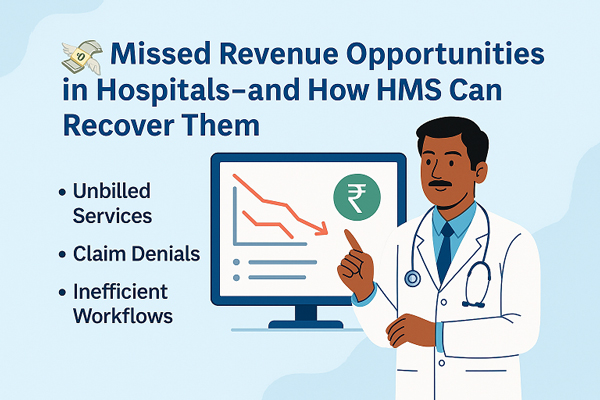Missed Revenue Opportunities in Hospitals—and How HMS Can Recover Them
August 13, 2025🧭 Introduction
Despite increasing patient load, many hospitals across India and globally face shrinking margins. While operational costs rise, revenue often fails to keep pace. The issue? Hidden or missed revenue opportunities – income that hospitals should be earning but aren’t, due to system inefficiencies, manual errors or poor tracking.
For healthcare administrators and doctors focused on clinical excellence, these silent leaks are easy to overlook—but the financial impact can be significant. The good news? With the right Hospital Management Software (HMS), these gaps can not only be detected but also fixed.
❌ 1️⃣ Where Hospitals Commonly Lose Revenue
Let’s explore the most common causes of revenue leakage in healthcare institutions:
🔸 Unbilled or Underbilled Services
Procedures, lab tests or consultations sometimes go unrecorded—especially during emergencies or when manual systems are in use. A radiology scan that isn’t logged into the billing system or a procedure not coded correctly means direct revenue loss.
🔸 Insurance Claim Denials
Poor documentation, incorrect coding or missing information can lead to delayed or denied insurance claims. Often, hospitals lack a structured process to follow up, resulting in permanent revenue loss.
🔸 Inventory Mismanagement
Medications or consumables used in inpatient settings may not always be tagged against patient bills. Also, lack of expiry alerts or overstocking can lead to wastage, indirectly affecting hospital profitability.
🔸 Missed Follow-ups and Appointments
No-shows and missed follow-ups don’t just affect patient outcomes—they also translate into loss of potential revenue and disrupt optimal use of hospital resources like doctors’ time and diagnostic facilities.
🔸 Data Entry Errors
In hospitals still relying on paper-based records or siloed software systems, duplicate records, incorrect patient entries or missed services are common—and they all result in lost income.
📉 According to an HFMA study, hospitals lose 1–3% of their net revenue annually due to these process inefficiencies. That’s ₹10–30 lakhs for a hospital with ₹10 crore in revenue.
📝 2️⃣ The Hidden Cost of Manual Systems
Hospitals that still rely on spreadsheets, paper records or disconnected software modules are at greater risk of financial leakage. Manual tracking is prone to:
- Missed charges
- Delayed billing cycles
- Limited audit capabilities
- Staff dependency for routine tasks
Imagine this:
A lab test worth ₹600 goes unbilled five times a week. That’s ₹12,000/month and ₹1.44 lakh/year—just from one service!
Multiply that across departments and the losses become substantial.
💡 3️⃣ How HMS Platforms Help Recover Lost Revenue
A Hospital Management Software acts as both a clinical and financial nervous system of your hospital. It automates, integrates and monitors every process that touches patient care and billing.
Here’s how:
✅ Real-Time Billing Integration
HMS Platform links services directly to billing. As soon as a test is ordered or a service is rendered, it is logged into the patient account. No more missed charges.
✅ Insurance & TPA Automation
The HMS validates all mandatory insurance claim fields before submission, tracks status and alerts staff on rejections or pending documents—dramatically improving claim recovery rates.
✅ Inventory-to-Patient Mapping
Each item issued from the pharmacy or store is mapped to patient usage in real time. This ensures nothing used goes unbilled and helps manage stock flow efficiently.
✅ Financial Dashboards & Reports
Visual dashboards show revenue trends, collections, pending bills, and department-wise earnings—empowering administrators to take data-backed decisions.
✅ Appointment & Follow-up Management
Automated reminders for patients reduce no-shows. Doctors’ calendars are optimized, ensuring higher throughput and revenue per hour.
📊 4️⃣ Real Impact: Before and After HMS
Let’s consider a 150-bed hospital in Gujarat that implemented HMS:
Before:
- 18–20% of OPD charges were missed monthly due to handwritten slips and poor coordination between departments.
- Claim rejections averaged ₹4–5 lakh quarterly.
- No accurate data on department-wise performance.
After:
- OPD revenue went up by 22% in the first quarter post-implementation.
- Claim processing time reduced by 40%, with real-time alerts on missing documentation.
- Revenue insights helped optimize staffing and diagnostics scheduling.
💡 HMS helped them recover ₹8.5 lakh in the first year alone.
🔍 5️⃣ Features to Look for in Revenue-Centric HMS
To maximize revenue and reduce leakage, ensure your HMS offers:
✔️ End-to-end billing capture
✔️ Role-based access and user tracking
✔️ Real-time inventory and expiry alerts
✔️ Integrated TPA and insurance workflows
✔️ Customizable MIS and financial dashboards
✔️ Auto-generated charge sheets per patient
✔️ Patient follow-up tracking and reminders
Not every HMS offers these by default—choose one that’s designed for financial performance and clinical efficiency.
✅ 💼 Conclusion: Plug the Leaks, Maximize Your Earnings
For hospitals looking to improve their bottom line without increasing workload or patient volume, recovering missed revenue is a strategic first step. From unbilled services and insurance delays to inventory misuse, there are multiple points where income quietly slips through the cracks.
A powerful, integrated Hospital Management Software (HMS) doesn’t just improve workflow—it becomes your financial watchdog. When every charge is captured, every document is tracked, and every claim is monitored, you turn operational precision into real profit.
🚀 SoftClinic GenX is built to help hospitals uncover hidden revenue, automate processes and bring total transparency across departments – from front desk to pharmacy to finance.
👉 Request a free personalized demo and discover how SoftClinic GenX can help your hospital plug revenue leaks—seamlessly.
